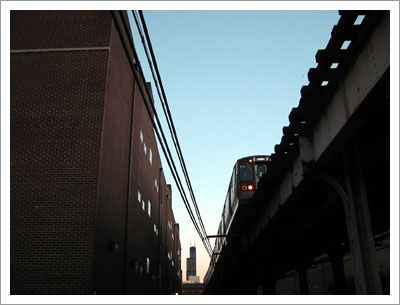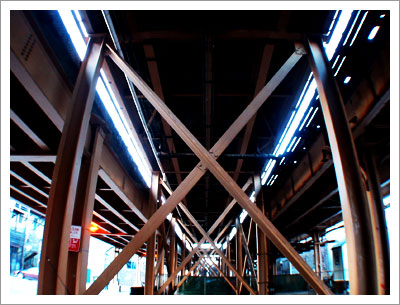"He walked beneath the shadow of the El. Through the sickness and heat of his third summer he had slept quietly only under the shadow of the Division Street station. In the heat of the city, in the heat of midsummer, the platform had sheltered him. Now he remembered the sun as a hostile thing coming between El ties; remembered sunlight as others recall it seen first through trees or climbing vines."
Nelson Algren -- The Trouble with Daylight, from Never Come Morning, 1942.
The rumble comes from someplace else, unnoticed at first until it forces its way into your consciousness like a thunderclap: low, grumbling, a block or two away, easy to ignore in the way it's possible to ignore all of the sounds of a city until you're sure that they matter to you personally. So you pay attention to the ground, maybe, littered with windblown garbage, or your cigarette, or your shoes, or the chill in the air and the weak winter sunlight passing through the millions of holes in the ironwork that holds the whole thing up. But then, unmistakably, it's there -- the passing train, right above you, traveling at 20 miles an hour, reverberating off of the warehouse walls, blocking out the light, filling the space with the sounds of steel on steel and the weight of hundreds of commuters on their way to someplace else.
A couple of tons of train passing a story or two above your head can be unnerving at first -- just walk over to Wabash and Van Buren and watch the tourists put their hands over their ears to remember what it was like the first time you heard it. It shakes the posts, the ones that soar up out of the concrete anchors, and you can see the little pebbles and shards of broken glass jump around your feet like multicolored jumping beans. Or the outstretched hands of the man looking for change a couple of blocks over. Then, a minute or so later, it's gone, the low rumble trailing off in the other direction, leaving you with nothing more alive than what you came with.

Fig1. The el above, coming straight for you.
The tracks here are higher than almost anyplace else in the city. They have to be to pass over the old Illinois Central Gulf tracks that cut through the middle of the block, turning the area underneath the El north of 15th Street and west of Wabash into a kind of a room, with warehouse buildings on either side and a roof of steel. The Illinois Central tracks that make up the north wall sit on a squat bed that looks like it could have been built sometime around the Civil War: huge granite blocks, cut roughly into squares, piled one on top of another for half a story, interrupted just enough to let the alley run through, and spanned by rusted iron that once held tracks of their own to ferry the commerce of the city on its way somewhere else.
Back then, whenever it was that the Illinois Central tracks first pushed westward from the lake, 15th Street was a lot closer to the edge of Chicago, both literally and metaphorically, than it is today. The whole Near South Side, in fact, was little more than a staging area for refrigerated cars carrying butter or beef carcasses waiting to be shipped to those who saw Chicago not just as the closest big city but as the only metropolis between them and the Atlantic Ocean. When it came time to build some kind of public transportation for the masses, years later, there probably wasn't much question about who had the right of way. Or who was going to have to travel over or around whom.
So up the El tracks go, higher here than almost anyplace else. Two full stories high, actually -- you can tell by measuring them against the broken windows of the warehouse a child's arm length from the track's edge. Dirty and grimy windows, screened and barred against all intruders bigger than a well-aimed rock. Two stories, and you can feel the girders rise, higher than other tracks you've known, extra sets of latticework needed in the spaces between them in the continuing hope that gravity can be defied with the mathematics and engineering of another century.
In fact, everything here seems infused with latticework, a cathedral of rusting iron and steel that breaks the light into minute slivers cascading down, only to be swallowed up by the darkened corners and the abandoned past of the alley below. And except for the every-few-minutes rumble of another passing Green or Orange Line train, things are pretty quiet down here; a church whose liturgy is the passing of those on their way from one place to another, willfully forgetting the space over which they must travel to get there.

Fig2. Admire the craft in that latticework.
The congregation has changed over the years, of course, something you can see just by stopping for a minute and looking around you. The dirt from past generations is here, along with the blank warehouse walls and the mangled iron gate that once kept the homeless from setting up shop between the loading dock and the Illinois Central tracks. But wait long enough, just a few minutes really, and a smart-looking SUV will glide by, past the empty liquor bottles and the broken chairs and charred tree branches, looking somewhat ridiculous in its oversized glossiness and making the steel girders look more like toys than the infrastructure of a mighty city. You can see it, too, in the expensive jogging outfits of the new urban pioneers who have turned every e mpty warehouse into high-priced lofts. Along with the three-wheeled baby carriages, and the pedestrians with cell phones, and the shaggy-haired kids on bikes, and the suits, and the cops, and the delivery trucks, and the construction sheds, and the No Parking signs that say you'd better have a deeded parking space somewhere around here to call home or else go back where you belong.
Which, as it turns out, isn't here, unless you've just arrived and signed your name on some mortgage papers. For whoever and whatever else it was that surrounded the El tracks is mostly gone now. Gone are the working men who once congregated for a smoke on shift breaks. Gone are those who couldn't afford train fare but gratefully walked under the tracks' protective umbrella, those who knew where one neighborhood ended and another began, and measured it by the length of track that ran between Wabash and State. Gone, too, isthe technological marvel of a world-class transportation system that was once shiny and new and marv eled at, replaced by a rusted and decaying one. And now ignored by those who only see it as an obstacle to be navigated outside of their fenced-in parking lot.
Whereas the space under the El tracks once somehow mattered, even if only to a few, now it matters to none.
In ways too numerous to count, the America, the Chicago, and the time in which the space under the El tracks mattered are long gone, and so are most of those to whom it mattered. It's difficult to imagine places more mundane, more proletarian, than these. But Chicago is full of little such hideaways of municipal and public after-thoughts, left over from the days when the El tracks ran through neighborhoods and communities as neatly as a butcher's cleaver and often just as ruthlessly. Today, decades since the automobile negated the need for many to even come close to public transportation sites, these open yet hidden spaces are more than just an afterthought meant to be avoided and forgotten. For should we choose to view these places in a more forgiving light, we may realize that it is here, perhaps more than the glitzy tourist locales and corporate office building plazas, that the memory of the city and its communities is kept on public display.
After all, history is constructed of stories both large and small, and in artifacts both public and private, desired and discarded. Should we look hard enough, the unused spaces underneath El tracks offer more than just an empty chunk of necessary urban space, but provide us a window directly into the past. To remind us of a time in urban America's history when futures remained to be written, public achievements were celebrated by the very public they were meant to serve, and even the mundane required a form of beauty and a sense of reverence.
If you try look hard enough, you can still find such a time at 15th and Wabash. And you can hear it, too, every few minutes or so, whenever a Green or Orange Line train goes about its business.





